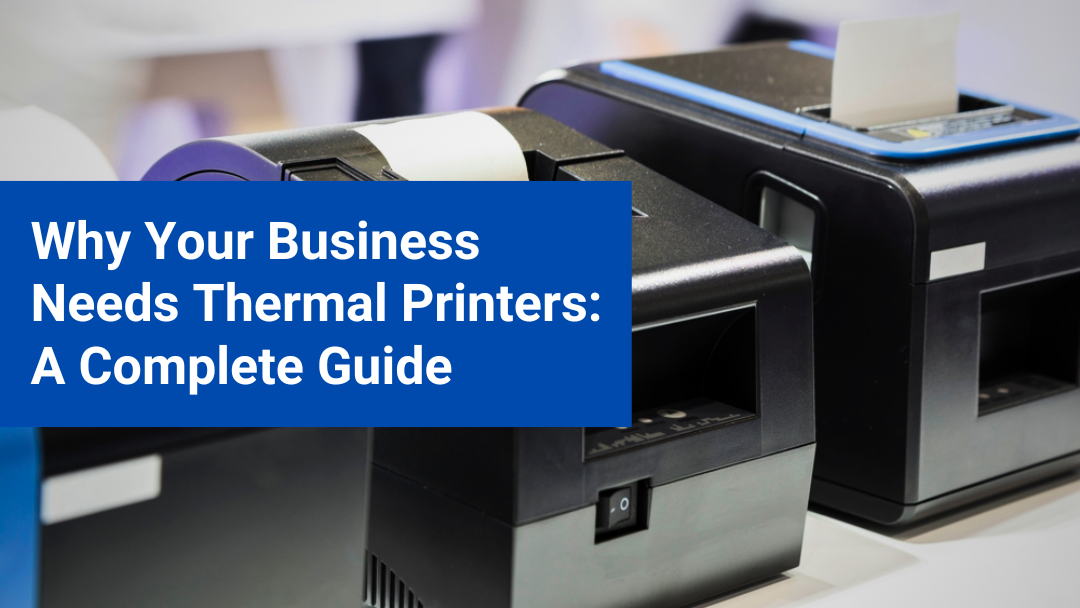Why Your Business Needs Thermal Printers : A Complete Guide
Are you confused if you should invest in thermal printers? If yes, this article will clear all your doubts and guide you to choose the right thermal printer for boosting your business. To explore, scroll till the last.
What are thermal printers?
Thermal printers are printers that use heat to produce images or text on paper. Known for their speed, reliability, and low maintenance, thermal printers are commonly used for printing receipts, labels, barcodes, and tickets. They are widely utilized in industries like retail, logistics, healthcare, and manufacturing due to their efficiency, low operating costs, and ability to produce durable, high-quality prints.
Types of thermal printers:
Majorly, thermal printers are of two types:
1) Direct Thermal Printers:
- How They Work: Direct thermal printers use heat-sensitive paper that darkens when heated by the printer’s thermal print head. The print head applies heat directly to the paper, creating images or text.
- Common Uses: Ideal for printing receipts, shipping labels, barcodes, and tickets. Common in retail, logistics, and healthcare.
- Advantages: No ink or ribbon required, low maintenance, fast printing.
-
2) Thermal Transfer Printers:
- How They Work: Thermal transfer printers use a heated ribbon coated with wax, resin, or both, which melts onto the paper or other materials to create durable prints.
- Common Uses: Suitable for printing durable labels, tags, and barcodes on various materials, including paper, plastic, and fabric. Often used in manufacturing and warehousing.
- Advantages: Produces high-quality, long-lasting prints that resist fading and withstand harsh conditions.
Both types of thermal printers are valued for their efficiency, reliability, and versatility in business applications.
Why are thermal printers essential for modern business?
Thermal printers are essential for modern business growth due to their efficiency, cost-effectiveness, and reliability, which directly contribute to improved operations and customer satisfaction. Here’s how they support business growth:
1) Improves Operational Efficiency:
- Fast Printing: Thermal printers deliver high-speed printing, which is crucial for businesses that must handle large volumes of transactions, such as retail, logistics, and healthcare. This speed enhances productivity and reduces wait times, improving customer service.
- Low Maintenance: With fewer moving parts and no need for ink or toner, thermal printers require minimal maintenance. This reduces downtime and ensures continuous operation, keeping business processes smooth and efficient.
2) Saves Money:
- Lower Operating Costs: Thermal printers eliminate the need for expensive ink or toner, reducing ongoing costs. Their durability and longevity mean fewer replacements and repairs, leading to long-term savings.
- Reduced Waste: The lack of ink cartridges and toners minimizes waste, which is both cost-effective and environmentally friendly.
3) Versatile in Nature:
- Multiple Applications: Thermal printers are versatile and can be used across various sectors for printing receipts, labels, barcodes, tickets, and more. This adaptability allows businesses to use the same technology for different purposes, simplifying operations and reducing equipment needs.
- Mobility: Many thermal printers are portable, making them ideal for businesses that require on-the-go printing, such as delivery services or mobile retail operations.
4) Improves Customer Experience:
- Quick and Reliable Service: Fast, reliable printing enhances the customer experience by reducing wait times and ensuring accurate transactions, whether at a checkout counter, in a hospital, or during a delivery.
- Consistent Quality: Thermal printers produce clear, consistent prints, ensuring that receipts, labels, and barcodes are always easy to read, reducing errors, and improving customer trust.
5) Supports Modern Business Practices:
- Integration with Technology: Thermal printers easily integrate with modern point-of-sale (POS) systems, inventory management software, and other digital platforms, supporting automation and data-driven decision-making.
- Scalability: As businesses grow, thermal printers can scale with them, handling increased workloads without compromising performance.
In summary, thermal printers play a critical role in modern business growth by enhancing efficiency, reducing costs, improving customer service, and supporting technological integration. Their reliability and versatility make them indispensable tools in today’s fast-paced business environment.
How to pick the right thermal printer for your business?
When investing in thermal printers for your business, it’s important to consider several factors to ensure you choose the right equipment that meets your needs and provides long-term value. Here are key points to consider:
1) Type of Thermal Printer:
- Direct Thermal vs. Thermal Transfer: Choose between direct thermal printers, which are ideal for short-term printing needs (like receipts), and thermal transfer printers, which are better for durable, long-lasting prints (like labels and tags).
- Application Requirements: Consider what you’ll be printing—receipts, barcodes, labels, or something else—since different printers are better suited for specific tasks.
2) Print Volume and Speed:
- Expected Volume: Assess your daily or monthly printing volume to ensure the printer can handle your needs without frequent maintenance or replacement.
- Printing Speed: Higher speeds are essential for businesses with high transaction volumes, such as retail or logistics. Ensure the printer can keep up with your pace.
3) Print Quality:
- Resolution: Consider the print resolution required for your application. High-resolution printers are necessary for printing detailed barcodes or graphics.
- Durability: For applications requiring durable, long-lasting prints, such as product labels, choose a printer that offers high-quality output that resists fading, smudging, or damage.
4) Connectivity and Integration:
- Compatibility: Ensure the printer is compatible with your existing systems, such as POS, inventory management software, or mobile devices.
- Connectivity Options: Look for printers with various connectivity options (USB, Bluetooth, Wi-Fi, Ethernet) based on your setup and whether you need mobile or networked printing.
5) Cost and Budget:
- Initial Cost vs. Long-Term Value: Compare the upfront cost of the printer with its expected lifespan, maintenance costs, and consumable costs (like ribbons for thermal transfer printers).
- Consumables: Consider the availability and cost of consumables (thermal paper, ribbons). Direct thermal printers save on ribbon costs, while thermal transfer printers might require more expensive materials.
6) Durability and Reliability:
- Build Quality: Choose a printer designed to withstand your operating environment, especially if you work in harsh conditions (e.g., manufacturing, warehousing).
- Brand Reputation: Opt for reputable brands known for reliable and durable printers, with good customer reviews and support services.
7) Ease of Use and Maintenance:
- User-Friendly Interface: Look for a printer that is easy to set up and operate, with clear instructions and minimal training required.
- Maintenance Needs: Consider how easy it is to maintain the printer, including cleaning and replacing parts. A printer with fewer moving parts will generally be easier to maintain.
8) Portability:
- Mobility Needs: If your business requires on-the-go printing, choose a compact, portable thermal printer that is lightweight and easy to transport.
9) Environmental Factors:
- Energy Efficiency: Choose a printer that is energy-efficient to reduce operating costs and environmental impact.
- Sustainability: Consider printers that use recyclable materials or have features that reduce waste, such as energy-saving modes.
10) Support and Warranty:
- Customer Support: Ensure the manufacturer or vendor provides reliable customer support for troubleshooting and repairs.
- Warranty: Look for printers that come with a robust warranty, covering parts and labor, to protect your investment.
By considering these factors, you can select a thermal printer that aligns with your business needs, budget, and long-term goals.
SUMMING UP
Thermal printers are essential for modern businesses due to their speed, cost-effectiveness, and reliability. They reduce operating costs by eliminating the need for ink or toner, offer high-quality and durable prints, and are versatile for various applications like receipts, labels, and barcodes. Their low maintenance and ability to integrate with modern systems make them indispensable tools for enhancing efficiency and improving customer service in diverse industries.

